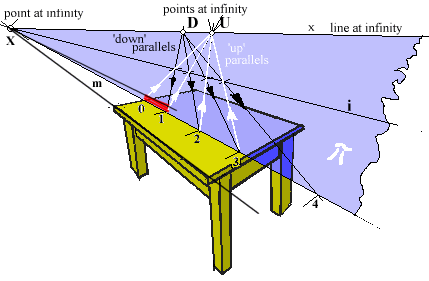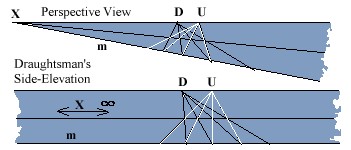Measurement
Preamble: the (distinct) lines of a line-pair in a plane are parallel if they form an angle of zero. The vertex of that angle, i.e., the meeting point of the pair, lies at—and exactly specifies the whereabouts of—infinity. *
So what is Measurement?
To approach an answer, we might ask, “What do we actually do, in real life,when we measure?”
- We lay down a ruler of a known number of supposedly equal units,
- with one end matching the start of the thing to be measured.
- We note where, on the measured thing, the other end of our ruler falls, and mark that place.
- Then we lift the ruler away, and re-lay it with its first end matching the mark - and so on,
- until we have spanned the thing we are measuring - and we count layings as we go.
- That done, we multiply the number of units on the ruler by the number of layings.
So the procedure is: lift and lay, rhythmically and serially, counting (adding) until done.
Let us now cast this procedure in the simplest geometrical terms.

We measure a table-top along the line m, as on the left (m is parallel to the table's edge). We lift the red ruler, keeping it parallel to itself in the blue plane π (which has the line m in the plane of the table-top), and so that the endpoints of it move in parallel (white) lines toward point U at ∞, and stop in the line i, parallel to m. We re-lay the ruler in like manner, except the direction of motion of the endpoints changes to the parallel (black) lines from point D at ∞, so as to place the left end of the ruler where the right end was. Count, and repeat.
Do observe that keeping the 'red ruler parallel to itself' involves rotating its line in point X at ∞, and in plane π (as shown in the animation). If lines move at all, they rotate: they do not translate. *
Here, we seem to get a total of something between 3 and
4 ruler's-worth
of 'length' for this table-top.
Note that point X, at ∞, is in plain sight, or rather - because points are invisible - it is in our field of vision. So are points D and U, also at ∞, in our field of vision.
If we turn our eyes to rotate X as far out-of-sight as it can ever be, then m, i and x will seem parallel, and all the intervals will seem equal in the accustomed way. We get the Draughtsman's ‘Side Elevation’.
(You can do this below.)

However, because Synthetic Geometry preserves only elementary incidence,
it has no Axiom of Equality.
Consequently, distance cannot be expressed as a sum of equal units.
I wish seriously to suggest that it is because our faculty of sight somehow incorporates and understands this transformational process as a largely non-analytic, "instinctual" part of seeing, that we "know" the intervals are "equal", as immediately as we "know" this text is red, not yellow.
Perhaps this is what distinguishes sight from perception.
There must be such a distinction, since there are people who can see perfectly, but not recognise what it is they see (Oliver Sacks: "The Man who Mistook his Wife for a Hat")
any such iterated process
obeying only the laws of incidence
can produce a ‘measure’ with geometrically-identical, but not equal, intervals.
Specifically, the lines i and x,
both now through X in the animation above, need not
pass through
the same point on line m,
but can instead pass through
two, distinct, separated points, X and Y.
Indeed, we may place X and Y just where
we please
on line m,
giving us .....
.... Variations on the Theme of Linear Measure.
In this interactive, you may shift the red, yellow and black lines by dragging white points A, B and C, and rotate these lines around their white points, and so set the positions of invariant points X and Y. They may be sent to infinity, one at a time, or together, or they may be set locally, separately or together, illustrating the variations listed below. Change the intervals by dragging D and/or U, and shift the entire set of them using the yellow point. Larger version →
The Variations -
By the axioms of incidence, two real points may be related in exactly two ways: that is, they may be
- distinct, or
- coincident (degenerate).
Taking infinity to be the meeting place of parallels, the points of this (real) pair may be
- at infinity, or
- "local" (i.e., not at infinity),
 both points may be local and distinct
both points may be local and distinct both points may be local and coincident
(degenerate)
both points may be local and coincident
(degenerate) both points may be at infinity—and coincident
(degenerate), since there is just one place at infinity on a line
both points may be at infinity—and coincident
(degenerate), since there is just one place at infinity on a line one point may be local, while the other is at infinity
one point may be local, while the other is at infinity
These four “states of incidence” correspond to four “styles” of linear measure,
pertaining to translation of points in a line , according to the ‘constraints’ on the invariants:
 "Growth measure" the least constrained case
"Growth measure" the least constrained case "Perspective measure" the third-most constrained case
"Perspective measure" the third-most constrained case "Equal step measure" the most constrained case: it is taken as the Standard Reference Measure (SRM)
"Equal step measure" the most constrained case: it is taken as the Standard Reference Measure (SRM) "Exponential (or Geometric) measure" the second-most constrained case
"Exponential (or Geometric) measure" the second-most constrained case
* In the Euclidean world, rotation implies a change of some angle of a line to a reference line, which is to say that that angle does not stay constant during the rotation.
But the Euclidean angle between parallel lines is constant: in fact, it is always zero. This, after all, is exactly how, for Euclid, the parallelity of two lines is properly established. [If the angle between two lines is zero, those lines are, for Euclid, parallel.]
Thus, for Euclid, there is no rotation from one line to another, parallel, line, if rotation is a numerical change of angle. Yet, the only way a line can move – if it can move at all – is in a plane, and around a point, and this is as true for Euclidean geometry as it is for Synthetic geometry. Now, as we can plainly see from the animation, such rotation does occur—so the Euclidean view must be mistaken.
The conclusion must be that, just as there is no way to find absolute rest, and none to find an absolute distance between points, there is no way to find an absolute, angular distance between lines—all, ultimately, because Synthetic geometry cannot support equal absolutes.